Human Resource Management Report: Future PLC's Strategy and Analysis
VerifiedAdded on 2023/04/05
|21
|4165
|277
Report
AI Summary
This report provides a comprehensive analysis of Human Resource Management (HRM) practices within Future PLC, a British public limited company. The report explores the purpose and function of HRM, including recruitment, safety, employee relations, and training and development. It examines the strengths and weaknesses of different recruitment approaches and evaluates HRM's role in fulfilling organizational goals and objectives. Furthermore, the report assesses the benefits of various HRM practices and evaluates their effectiveness in relation to rising organizational profit and productivity. It also delves into internal and external factors that influence HRM decision-making, providing critical evaluations throughout. Specific examples and a flowchart are used to illustrate HRM practices within an organizational context, offering insights into the application of specific HRM practices in a work-related context, and concludes with a discussion on the importance of adapting HRM strategies based on internal and external factors.
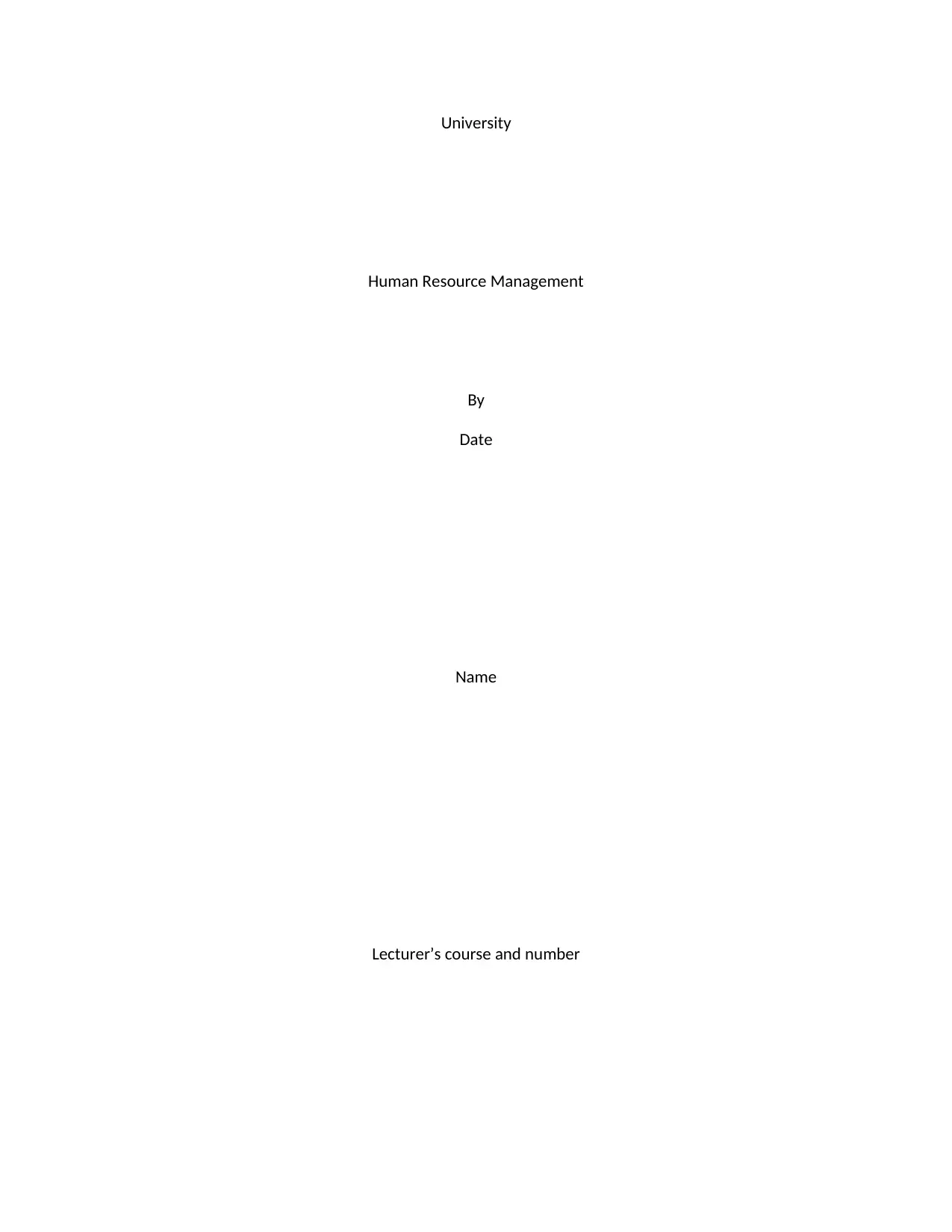
University
Human Resource Management
By
Date
Name
Lecturer’s course and number
Human Resource Management
By
Date
Name
Lecturer’s course and number
Paraphrase This Document
Need a fresh take? Get an instant paraphrase of this document with our AI Paraphraser
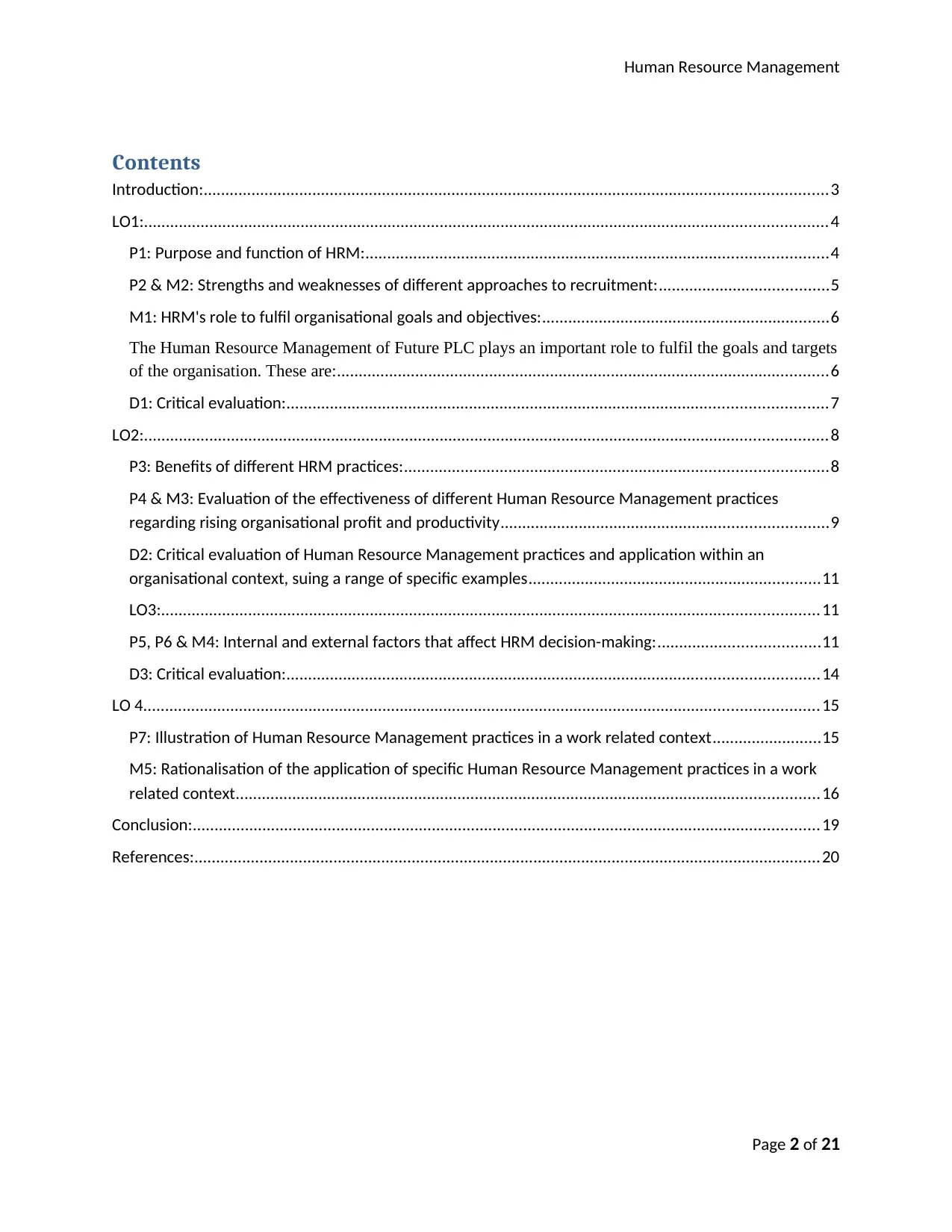
Human Resource Management
Contents
Introduction:...............................................................................................................................................3
LO1:.............................................................................................................................................................4
P1: Purpose and function of HRM:..........................................................................................................4
P2 & M2: Strengths and weaknesses of different approaches to recruitment:.......................................5
M1: HRM's role to fulfil organisational goals and objectives:..................................................................6
The Human Resource Management of Future PLC plays an important role to fulfil the goals and targets
of the organisation. These are:.................................................................................................................6
D1: Critical evaluation:............................................................................................................................7
LO2:.............................................................................................................................................................8
P3: Benefits of different HRM practices:.................................................................................................8
P4 & M3: Evaluation of the effectiveness of different Human Resource Management practices
regarding rising organisational profit and productivity...........................................................................9
D2: Critical evaluation of Human Resource Management practices and application within an
organisational context, suing a range of specific examples...................................................................11
LO3:.......................................................................................................................................................11
P5, P6 & M4: Internal and external factors that affect HRM decision-making:.....................................11
D3: Critical evaluation:..........................................................................................................................14
LO 4...........................................................................................................................................................15
P7: Illustration of Human Resource Management practices in a work related context.........................15
M5: Rationalisation of the application of specific Human Resource Management practices in a work
related context......................................................................................................................................16
Conclusion:................................................................................................................................................19
References:................................................................................................................................................20
Page 2 of 21
Contents
Introduction:...............................................................................................................................................3
LO1:.............................................................................................................................................................4
P1: Purpose and function of HRM:..........................................................................................................4
P2 & M2: Strengths and weaknesses of different approaches to recruitment:.......................................5
M1: HRM's role to fulfil organisational goals and objectives:..................................................................6
The Human Resource Management of Future PLC plays an important role to fulfil the goals and targets
of the organisation. These are:.................................................................................................................6
D1: Critical evaluation:............................................................................................................................7
LO2:.............................................................................................................................................................8
P3: Benefits of different HRM practices:.................................................................................................8
P4 & M3: Evaluation of the effectiveness of different Human Resource Management practices
regarding rising organisational profit and productivity...........................................................................9
D2: Critical evaluation of Human Resource Management practices and application within an
organisational context, suing a range of specific examples...................................................................11
LO3:.......................................................................................................................................................11
P5, P6 & M4: Internal and external factors that affect HRM decision-making:.....................................11
D3: Critical evaluation:..........................................................................................................................14
LO 4...........................................................................................................................................................15
P7: Illustration of Human Resource Management practices in a work related context.........................15
M5: Rationalisation of the application of specific Human Resource Management practices in a work
related context......................................................................................................................................16
Conclusion:................................................................................................................................................19
References:................................................................................................................................................20
Page 2 of 21
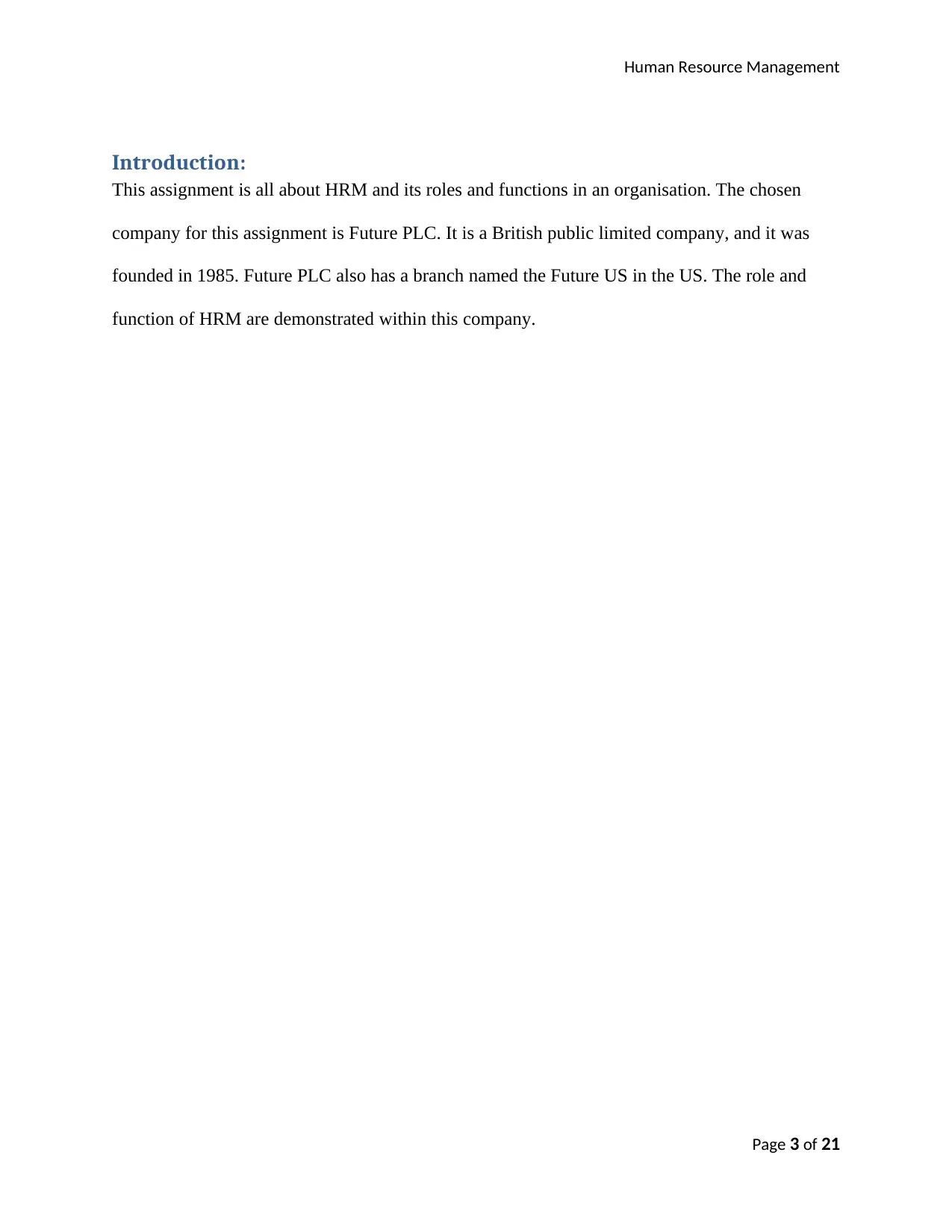
Human Resource Management
Introduction:
This assignment is all about HRM and its roles and functions in an organisation. The chosen
company for this assignment is Future PLC. It is a British public limited company, and it was
founded in 1985. Future PLC also has a branch named the Future US in the US. The role and
function of HRM are demonstrated within this company.
Page 3 of 21
Introduction:
This assignment is all about HRM and its roles and functions in an organisation. The chosen
company for this assignment is Future PLC. It is a British public limited company, and it was
founded in 1985. Future PLC also has a branch named the Future US in the US. The role and
function of HRM are demonstrated within this company.
Page 3 of 21
⊘ This is a preview!⊘
Do you want full access?
Subscribe today to unlock all pages.

Trusted by 1+ million students worldwide
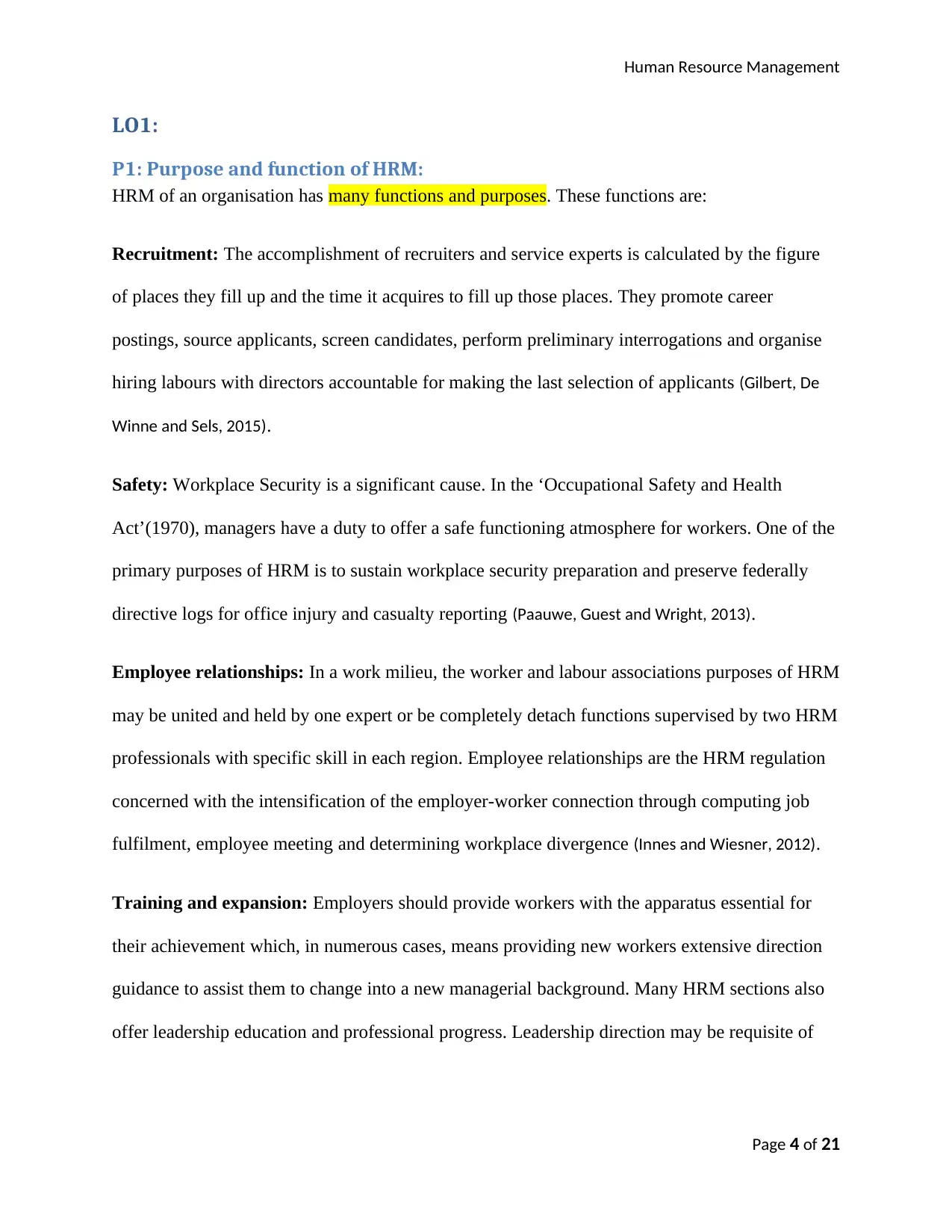
Human Resource Management
LO1:
P1: Purpose and function of HRM:
HRM of an organisation has many functions and purposes. These functions are:
Recruitment: The accomplishment of recruiters and service experts is calculated by the figure
of places they fill up and the time it acquires to fill up those places. They promote career
postings, source applicants, screen candidates, perform preliminary interrogations and organise
hiring labours with directors accountable for making the last selection of applicants (Gilbert, De
Winne and Sels, 2015).
Safety: Workplace Security is a significant cause. In the ‘Occupational Safety and Health
Act’(1970), managers have a duty to offer a safe functioning atmosphere for workers. One of the
primary purposes of HRM is to sustain workplace security preparation and preserve federally
directive logs for office injury and casualty reporting (Paauwe, Guest and Wright, 2013).
Employee relationships: In a work milieu, the worker and labour associations purposes of HRM
may be united and held by one expert or be completely detach functions supervised by two HRM
professionals with specific skill in each region. Employee relationships are the HRM regulation
concerned with the intensification of the employer-worker connection through computing job
fulfilment, employee meeting and determining workplace divergence (Innes and Wiesner, 2012).
Training and expansion: Employers should provide workers with the apparatus essential for
their achievement which, in numerous cases, means providing new workers extensive direction
guidance to assist them to change into a new managerial background. Many HRM sections also
offer leadership education and professional progress. Leadership direction may be requisite of
Page 4 of 21
LO1:
P1: Purpose and function of HRM:
HRM of an organisation has many functions and purposes. These functions are:
Recruitment: The accomplishment of recruiters and service experts is calculated by the figure
of places they fill up and the time it acquires to fill up those places. They promote career
postings, source applicants, screen candidates, perform preliminary interrogations and organise
hiring labours with directors accountable for making the last selection of applicants (Gilbert, De
Winne and Sels, 2015).
Safety: Workplace Security is a significant cause. In the ‘Occupational Safety and Health
Act’(1970), managers have a duty to offer a safe functioning atmosphere for workers. One of the
primary purposes of HRM is to sustain workplace security preparation and preserve federally
directive logs for office injury and casualty reporting (Paauwe, Guest and Wright, 2013).
Employee relationships: In a work milieu, the worker and labour associations purposes of HRM
may be united and held by one expert or be completely detach functions supervised by two HRM
professionals with specific skill in each region. Employee relationships are the HRM regulation
concerned with the intensification of the employer-worker connection through computing job
fulfilment, employee meeting and determining workplace divergence (Innes and Wiesner, 2012).
Training and expansion: Employers should provide workers with the apparatus essential for
their achievement which, in numerous cases, means providing new workers extensive direction
guidance to assist them to change into a new managerial background. Many HRM sections also
offer leadership education and professional progress. Leadership direction may be requisite of
Page 4 of 21
Paraphrase This Document
Need a fresh take? Get an instant paraphrase of this document with our AI Paraphraser
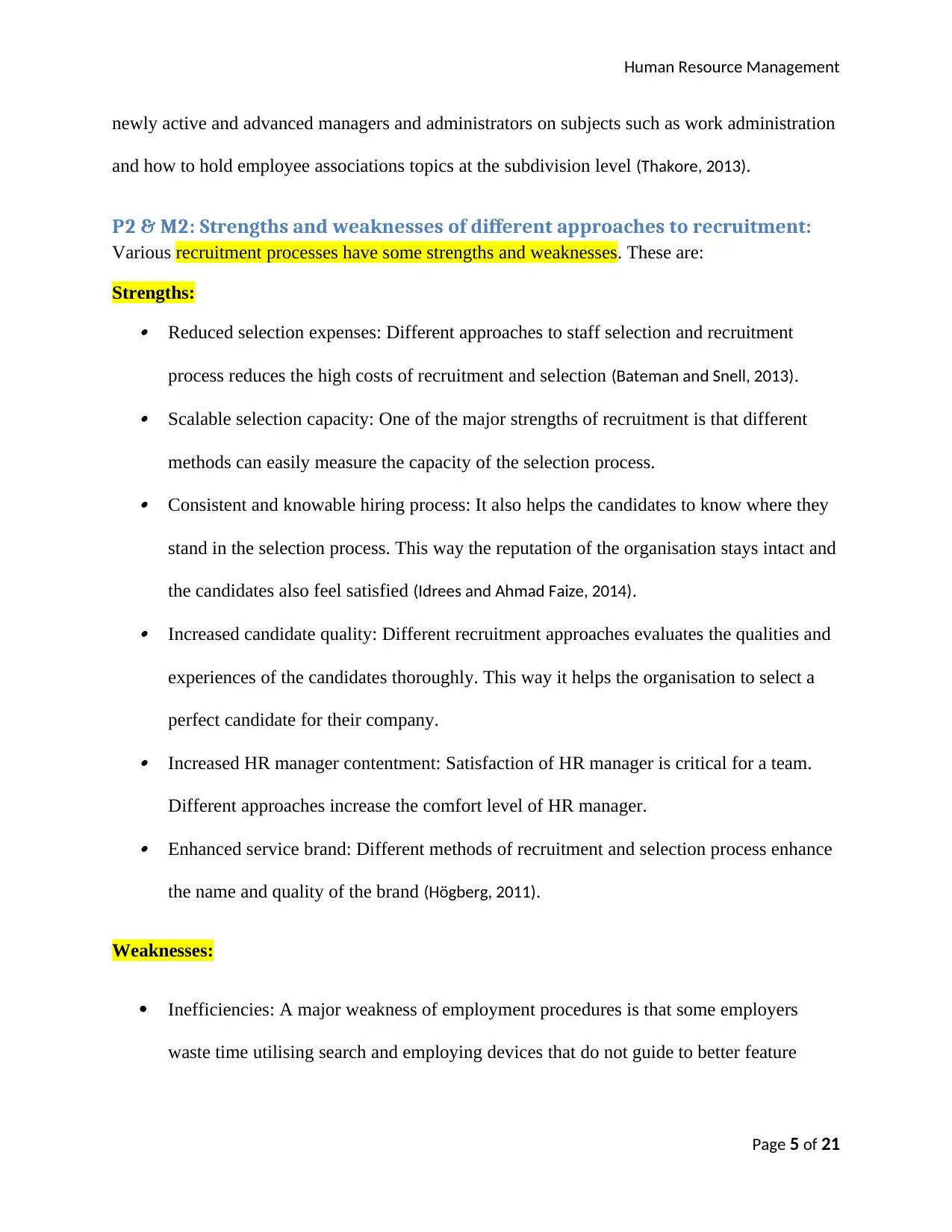
Human Resource Management
newly active and advanced managers and administrators on subjects such as work administration
and how to hold employee associations topics at the subdivision level (Thakore, 2013).
P2 & M2: Strengths and weaknesses of different approaches to recruitment:
Various recruitment processes have some strengths and weaknesses. These are:
Strengths: Reduced selection expenses: Different approaches to staff selection and recruitment
process reduces the high costs of recruitment and selection (Bateman and Snell, 2013). Scalable selection capacity: One of the major strengths of recruitment is that different
methods can easily measure the capacity of the selection process. Consistent and knowable hiring process: It also helps the candidates to know where they
stand in the selection process. This way the reputation of the organisation stays intact and
the candidates also feel satisfied (Idrees and Ahmad Faize, 2014). Increased candidate quality: Different recruitment approaches evaluates the qualities and
experiences of the candidates thoroughly. This way it helps the organisation to select a
perfect candidate for their company. Increased HR manager contentment: Satisfaction of HR manager is critical for a team.
Different approaches increase the comfort level of HR manager. Enhanced service brand: Different methods of recruitment and selection process enhance
the name and quality of the brand (Högberg, 2011).
Weaknesses:
Inefficiencies: A major weakness of employment procedures is that some employers
waste time utilising search and employing devices that do not guide to better feature
Page 5 of 21
newly active and advanced managers and administrators on subjects such as work administration
and how to hold employee associations topics at the subdivision level (Thakore, 2013).
P2 & M2: Strengths and weaknesses of different approaches to recruitment:
Various recruitment processes have some strengths and weaknesses. These are:
Strengths: Reduced selection expenses: Different approaches to staff selection and recruitment
process reduces the high costs of recruitment and selection (Bateman and Snell, 2013). Scalable selection capacity: One of the major strengths of recruitment is that different
methods can easily measure the capacity of the selection process. Consistent and knowable hiring process: It also helps the candidates to know where they
stand in the selection process. This way the reputation of the organisation stays intact and
the candidates also feel satisfied (Idrees and Ahmad Faize, 2014). Increased candidate quality: Different recruitment approaches evaluates the qualities and
experiences of the candidates thoroughly. This way it helps the organisation to select a
perfect candidate for their company. Increased HR manager contentment: Satisfaction of HR manager is critical for a team.
Different approaches increase the comfort level of HR manager. Enhanced service brand: Different methods of recruitment and selection process enhance
the name and quality of the brand (Högberg, 2011).
Weaknesses:
Inefficiencies: A major weakness of employment procedures is that some employers
waste time utilising search and employing devices that do not guide to better feature
Page 5 of 21
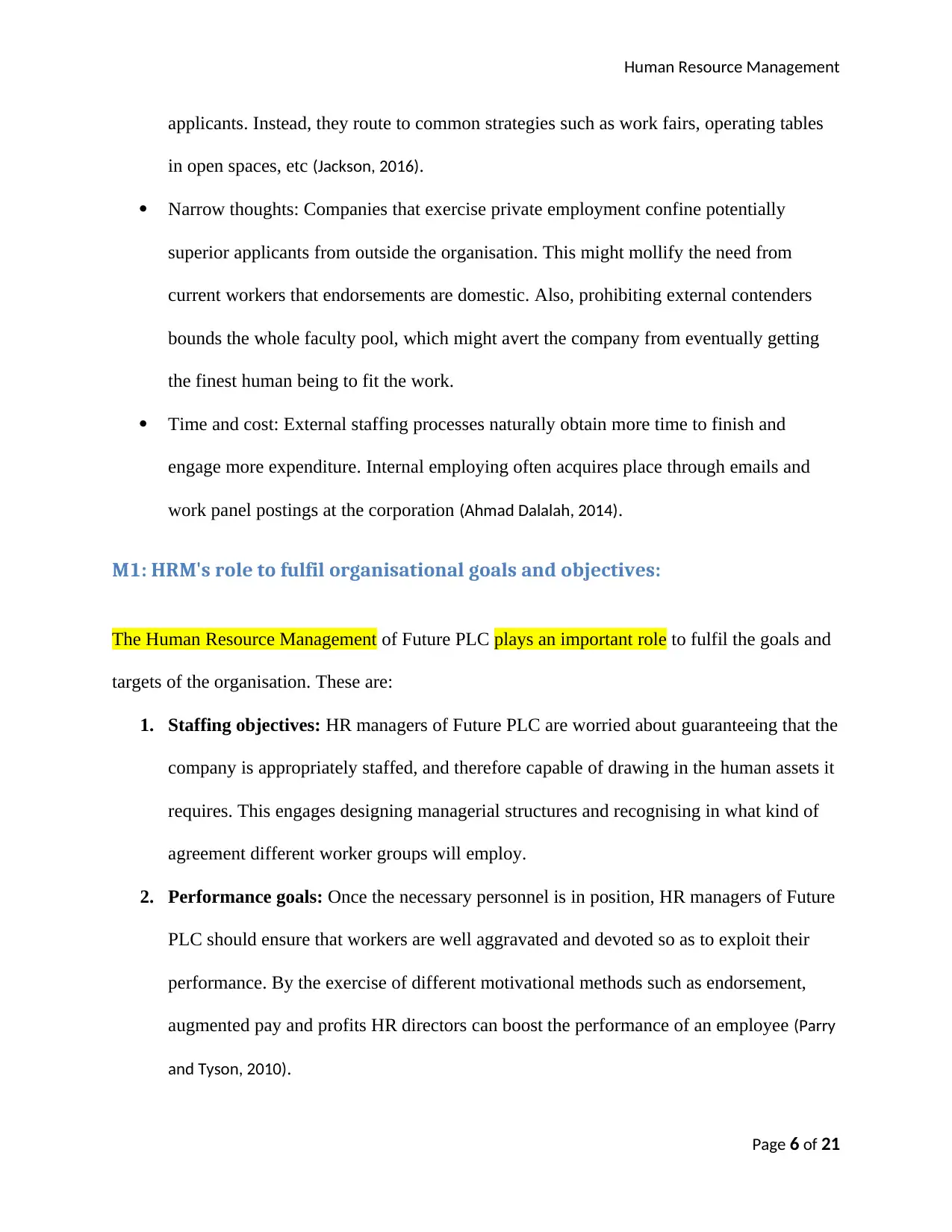
Human Resource Management
applicants. Instead, they route to common strategies such as work fairs, operating tables
in open spaces, etc (Jackson, 2016).
Narrow thoughts: Companies that exercise private employment confine potentially
superior applicants from outside the organisation. This might mollify the need from
current workers that endorsements are domestic. Also, prohibiting external contenders
bounds the whole faculty pool, which might avert the company from eventually getting
the finest human being to fit the work.
Time and cost: External staffing processes naturally obtain more time to finish and
engage more expenditure. Internal employing often acquires place through emails and
work panel postings at the corporation (Ahmad Dalalah, 2014).
M1: HRM's role to fulfil organisational goals and objectives:
The Human Resource Management of Future PLC plays an important role to fulfil the goals and
targets of the organisation. These are:
1. Staffing objectives: HR managers of Future PLC are worried about guaranteeing that the
company is appropriately staffed, and therefore capable of drawing in the human assets it
requires. This engages designing managerial structures and recognising in what kind of
agreement different worker groups will employ.
2. Performance goals: Once the necessary personnel is in position, HR managers of Future
PLC should ensure that workers are well aggravated and devoted so as to exploit their
performance. By the exercise of different motivational methods such as endorsement,
augmented pay and profits HR directors can boost the performance of an employee (Parry
and Tyson, 2010).
Page 6 of 21
applicants. Instead, they route to common strategies such as work fairs, operating tables
in open spaces, etc (Jackson, 2016).
Narrow thoughts: Companies that exercise private employment confine potentially
superior applicants from outside the organisation. This might mollify the need from
current workers that endorsements are domestic. Also, prohibiting external contenders
bounds the whole faculty pool, which might avert the company from eventually getting
the finest human being to fit the work.
Time and cost: External staffing processes naturally obtain more time to finish and
engage more expenditure. Internal employing often acquires place through emails and
work panel postings at the corporation (Ahmad Dalalah, 2014).
M1: HRM's role to fulfil organisational goals and objectives:
The Human Resource Management of Future PLC plays an important role to fulfil the goals and
targets of the organisation. These are:
1. Staffing objectives: HR managers of Future PLC are worried about guaranteeing that the
company is appropriately staffed, and therefore capable of drawing in the human assets it
requires. This engages designing managerial structures and recognising in what kind of
agreement different worker groups will employ.
2. Performance goals: Once the necessary personnel is in position, HR managers of Future
PLC should ensure that workers are well aggravated and devoted so as to exploit their
performance. By the exercise of different motivational methods such as endorsement,
augmented pay and profits HR directors can boost the performance of an employee (Parry
and Tyson, 2010).
Page 6 of 21
⊘ This is a preview!⊘
Do you want full access?
Subscribe today to unlock all pages.

Trusted by 1+ million students worldwide
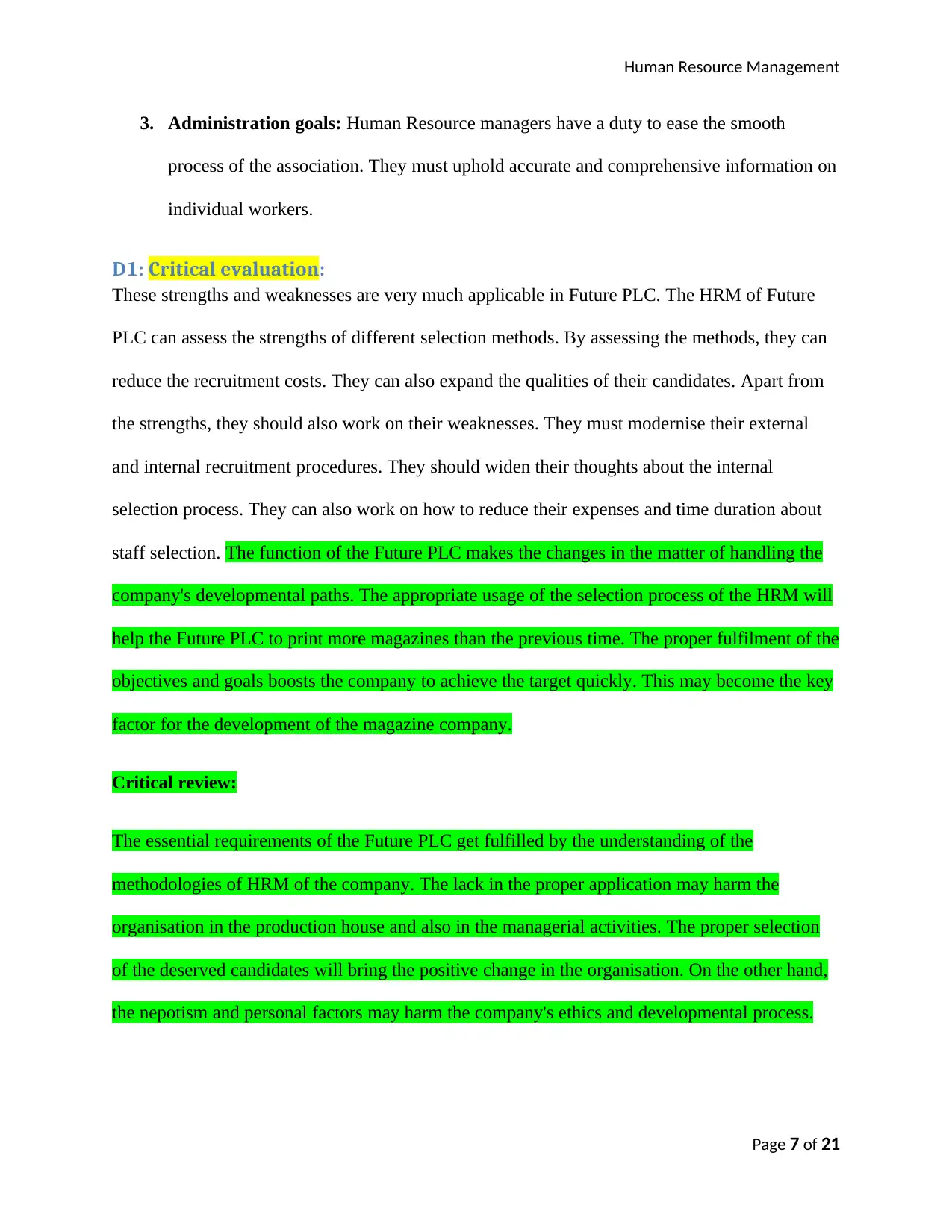
Human Resource Management
3. Administration goals: Human Resource managers have a duty to ease the smooth
process of the association. They must uphold accurate and comprehensive information on
individual workers.
D1: Critical evaluation:
These strengths and weaknesses are very much applicable in Future PLC. The HRM of Future
PLC can assess the strengths of different selection methods. By assessing the methods, they can
reduce the recruitment costs. They can also expand the qualities of their candidates. Apart from
the strengths, they should also work on their weaknesses. They must modernise their external
and internal recruitment procedures. They should widen their thoughts about the internal
selection process. They can also work on how to reduce their expenses and time duration about
staff selection. The function of the Future PLC makes the changes in the matter of handling the
company's developmental paths. The appropriate usage of the selection process of the HRM will
help the Future PLC to print more magazines than the previous time. The proper fulfilment of the
objectives and goals boosts the company to achieve the target quickly. This may become the key
factor for the development of the magazine company.
Critical review:
The essential requirements of the Future PLC get fulfilled by the understanding of the
methodologies of HRM of the company. The lack in the proper application may harm the
organisation in the production house and also in the managerial activities. The proper selection
of the deserved candidates will bring the positive change in the organisation. On the other hand,
the nepotism and personal factors may harm the company's ethics and developmental process.
Page 7 of 21
3. Administration goals: Human Resource managers have a duty to ease the smooth
process of the association. They must uphold accurate and comprehensive information on
individual workers.
D1: Critical evaluation:
These strengths and weaknesses are very much applicable in Future PLC. The HRM of Future
PLC can assess the strengths of different selection methods. By assessing the methods, they can
reduce the recruitment costs. They can also expand the qualities of their candidates. Apart from
the strengths, they should also work on their weaknesses. They must modernise their external
and internal recruitment procedures. They should widen their thoughts about the internal
selection process. They can also work on how to reduce their expenses and time duration about
staff selection. The function of the Future PLC makes the changes in the matter of handling the
company's developmental paths. The appropriate usage of the selection process of the HRM will
help the Future PLC to print more magazines than the previous time. The proper fulfilment of the
objectives and goals boosts the company to achieve the target quickly. This may become the key
factor for the development of the magazine company.
Critical review:
The essential requirements of the Future PLC get fulfilled by the understanding of the
methodologies of HRM of the company. The lack in the proper application may harm the
organisation in the production house and also in the managerial activities. The proper selection
of the deserved candidates will bring the positive change in the organisation. On the other hand,
the nepotism and personal factors may harm the company's ethics and developmental process.
Page 7 of 21
Paraphrase This Document
Need a fresh take? Get an instant paraphrase of this document with our AI Paraphraser
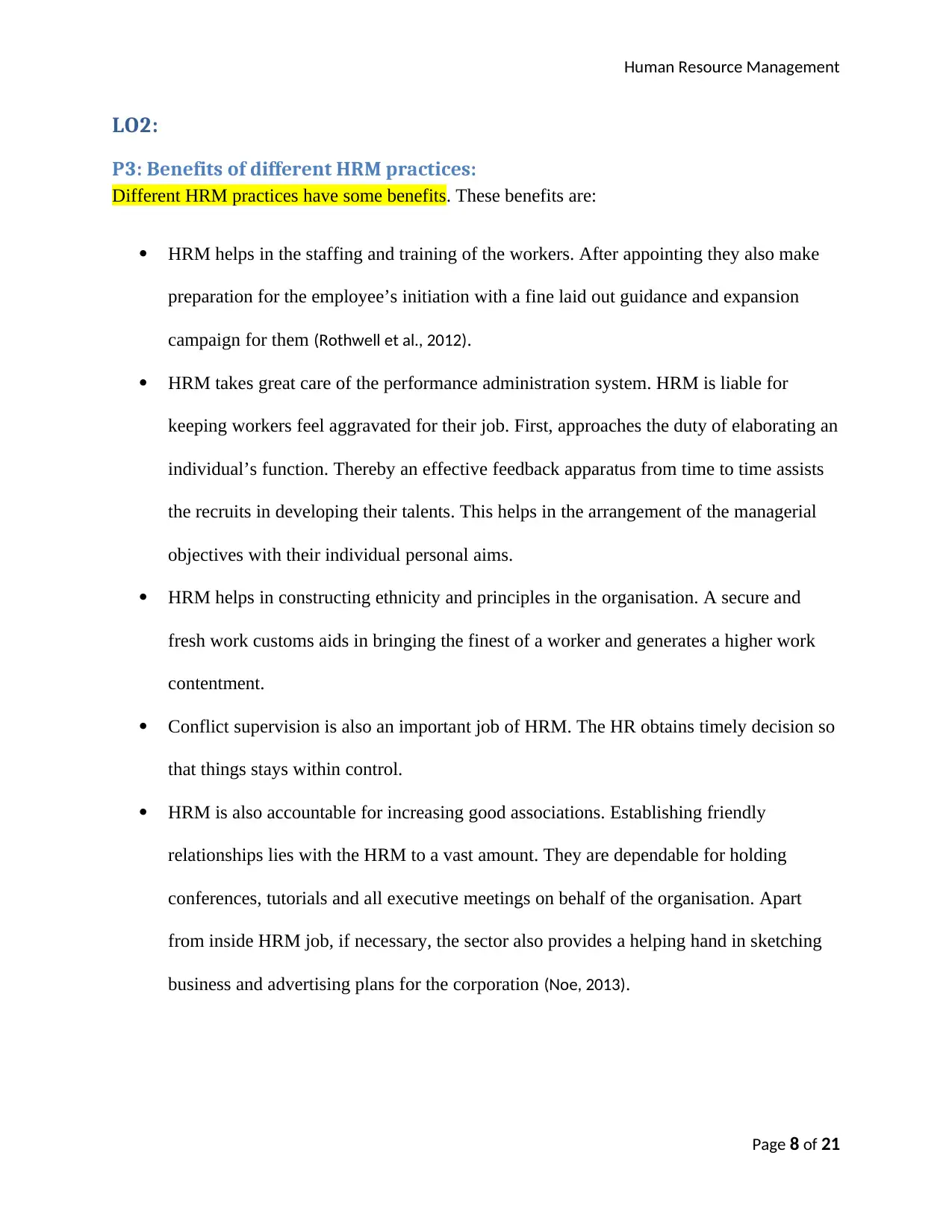
Human Resource Management
LO2:
P3: Benefits of different HRM practices:
Different HRM practices have some benefits. These benefits are:
HRM helps in the staffing and training of the workers. After appointing they also make
preparation for the employee’s initiation with a fine laid out guidance and expansion
campaign for them (Rothwell et al., 2012).
HRM takes great care of the performance administration system. HRM is liable for
keeping workers feel aggravated for their job. First, approaches the duty of elaborating an
individual’s function. Thereby an effective feedback apparatus from time to time assists
the recruits in developing their talents. This helps in the arrangement of the managerial
objectives with their individual personal aims.
HRM helps in constructing ethnicity and principles in the organisation. A secure and
fresh work customs aids in bringing the finest of a worker and generates a higher work
contentment.
Conflict supervision is also an important job of HRM. The HR obtains timely decision so
that things stays within control.
HRM is also accountable for increasing good associations. Establishing friendly
relationships lies with the HRM to a vast amount. They are dependable for holding
conferences, tutorials and all executive meetings on behalf of the organisation. Apart
from inside HRM job, if necessary, the sector also provides a helping hand in sketching
business and advertising plans for the corporation (Noe, 2013).
Page 8 of 21
LO2:
P3: Benefits of different HRM practices:
Different HRM practices have some benefits. These benefits are:
HRM helps in the staffing and training of the workers. After appointing they also make
preparation for the employee’s initiation with a fine laid out guidance and expansion
campaign for them (Rothwell et al., 2012).
HRM takes great care of the performance administration system. HRM is liable for
keeping workers feel aggravated for their job. First, approaches the duty of elaborating an
individual’s function. Thereby an effective feedback apparatus from time to time assists
the recruits in developing their talents. This helps in the arrangement of the managerial
objectives with their individual personal aims.
HRM helps in constructing ethnicity and principles in the organisation. A secure and
fresh work customs aids in bringing the finest of a worker and generates a higher work
contentment.
Conflict supervision is also an important job of HRM. The HR obtains timely decision so
that things stays within control.
HRM is also accountable for increasing good associations. Establishing friendly
relationships lies with the HRM to a vast amount. They are dependable for holding
conferences, tutorials and all executive meetings on behalf of the organisation. Apart
from inside HRM job, if necessary, the sector also provides a helping hand in sketching
business and advertising plans for the corporation (Noe, 2013).
Page 8 of 21
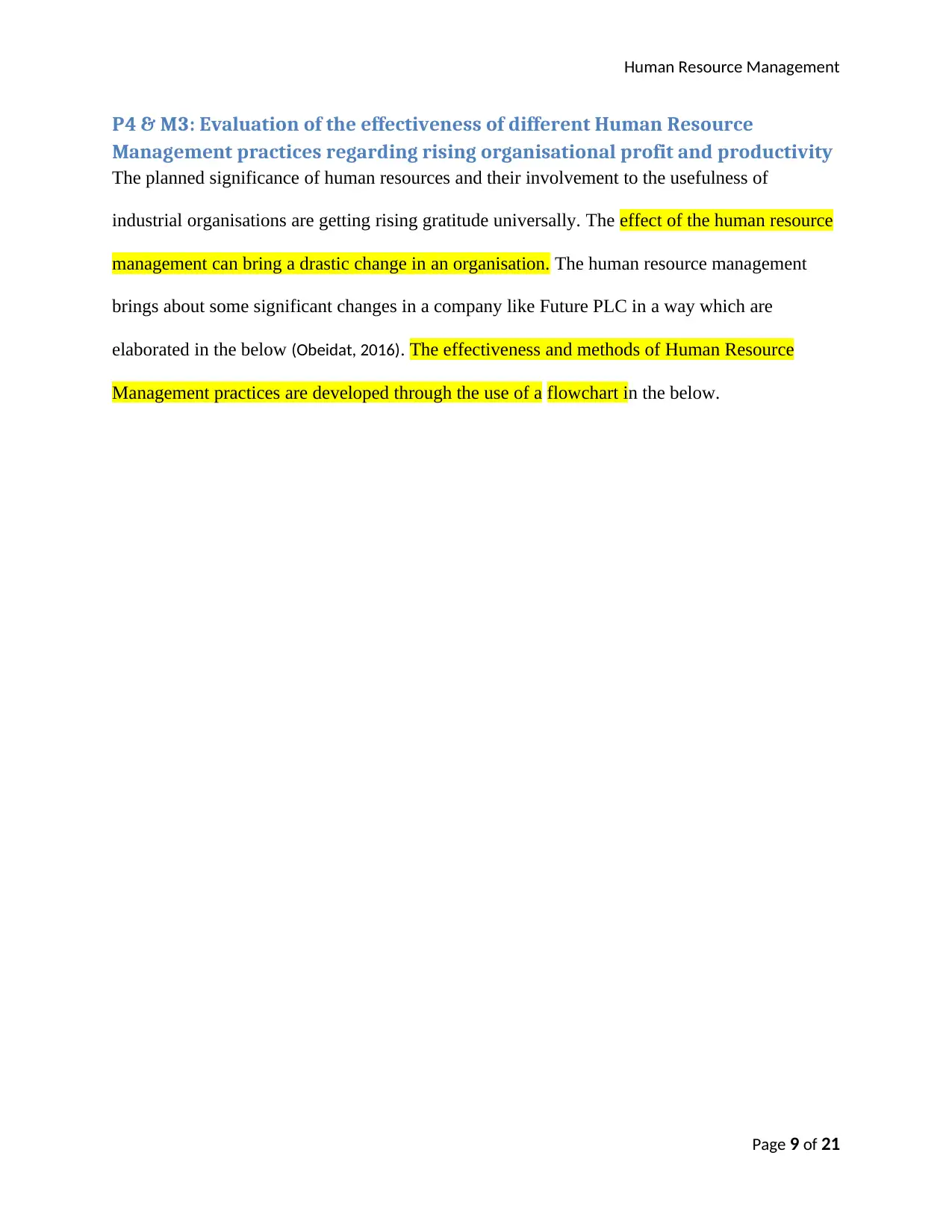
Human Resource Management
P4 & M3: Evaluation of the effectiveness of different Human Resource
Management practices regarding rising organisational profit and productivity
The planned significance of human resources and their involvement to the usefulness of
industrial organisations are getting rising gratitude universally. The effect of the human resource
management can bring a drastic change in an organisation. The human resource management
brings about some significant changes in a company like Future PLC in a way which are
elaborated in the below (Obeidat, 2016). The effectiveness and methods of Human Resource
Management practices are developed through the use of a flowchart in the below.
Page 9 of 21
P4 & M3: Evaluation of the effectiveness of different Human Resource
Management practices regarding rising organisational profit and productivity
The planned significance of human resources and their involvement to the usefulness of
industrial organisations are getting rising gratitude universally. The effect of the human resource
management can bring a drastic change in an organisation. The human resource management
brings about some significant changes in a company like Future PLC in a way which are
elaborated in the below (Obeidat, 2016). The effectiveness and methods of Human Resource
Management practices are developed through the use of a flowchart in the below.
Page 9 of 21
⊘ This is a preview!⊘
Do you want full access?
Subscribe today to unlock all pages.

Trusted by 1+ million students worldwide
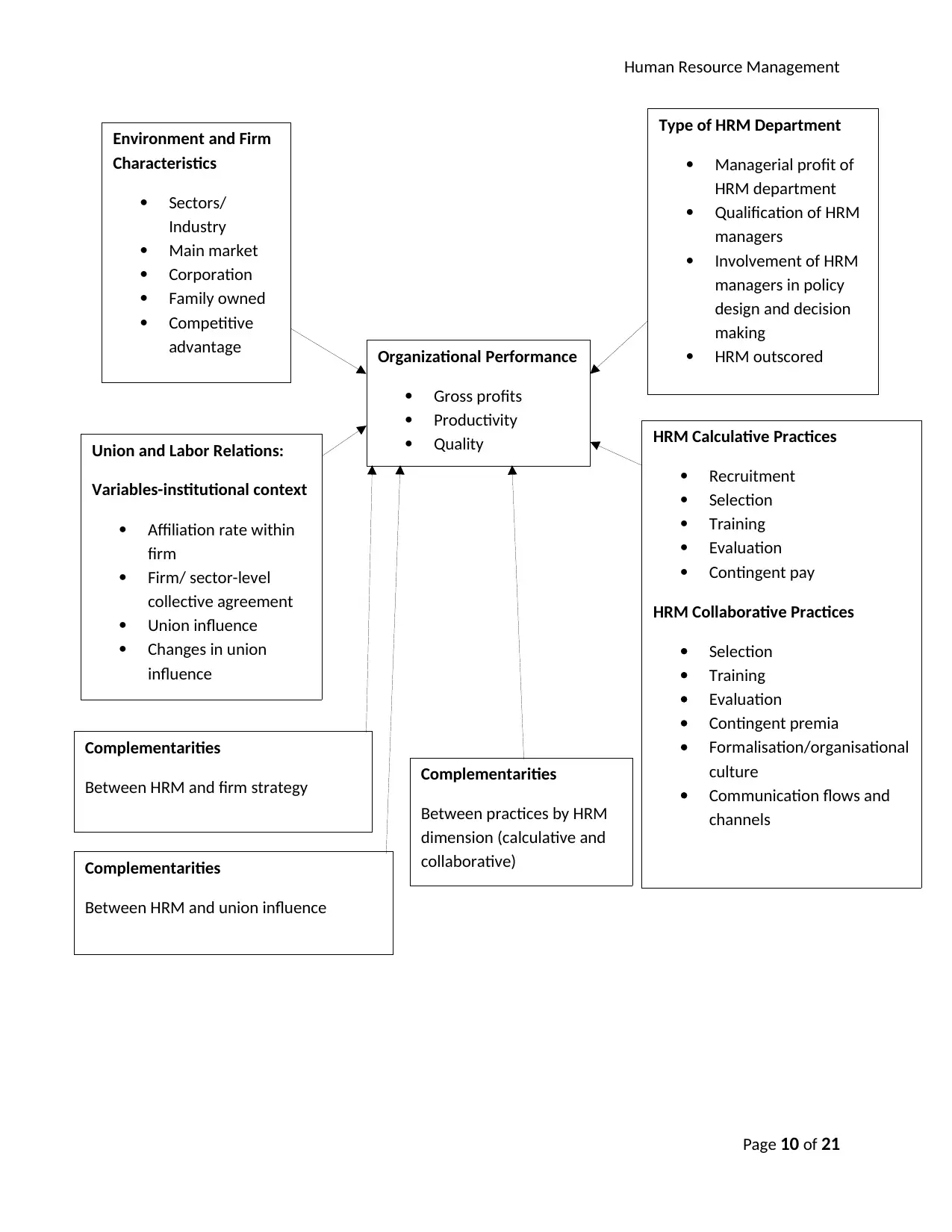
Human Resource Management
Page 10 of 21
Environment and Firm
Characteristics
Sectors/
Industry
Main market
Corporation
Family owned
Competitive
advantage Organizational Performance
Gross profits
Productivity
Quality
Type of HRM Department
Managerial profit of
HRM department
Qualification of HRM
managers
Involvement of HRM
managers in policy
design and decision
making
HRM outscored
Union and Labor Relations:
Variables-institutional context
Affiliation rate within
firm
Firm/ sector-level
collective agreement
Union influence
Changes in union
influence
Complementarities
Between HRM and firm strategy
Complementarities
Between HRM and union influence
Complementarities
Between practices by HRM
dimension (calculative and
collaborative)
HRM Calculative Practices
Recruitment
Selection
Training
Evaluation
Contingent pay
HRM Collaborative Practices
Selection
Training
Evaluation
Contingent premia
Formalisation/organisational
culture
Communication flows and
channels
Page 10 of 21
Environment and Firm
Characteristics
Sectors/
Industry
Main market
Corporation
Family owned
Competitive
advantage Organizational Performance
Gross profits
Productivity
Quality
Type of HRM Department
Managerial profit of
HRM department
Qualification of HRM
managers
Involvement of HRM
managers in policy
design and decision
making
HRM outscored
Union and Labor Relations:
Variables-institutional context
Affiliation rate within
firm
Firm/ sector-level
collective agreement
Union influence
Changes in union
influence
Complementarities
Between HRM and firm strategy
Complementarities
Between HRM and union influence
Complementarities
Between practices by HRM
dimension (calculative and
collaborative)
HRM Calculative Practices
Recruitment
Selection
Training
Evaluation
Contingent pay
HRM Collaborative Practices
Selection
Training
Evaluation
Contingent premia
Formalisation/organisational
culture
Communication flows and
channels
Paraphrase This Document
Need a fresh take? Get an instant paraphrase of this document with our AI Paraphraser
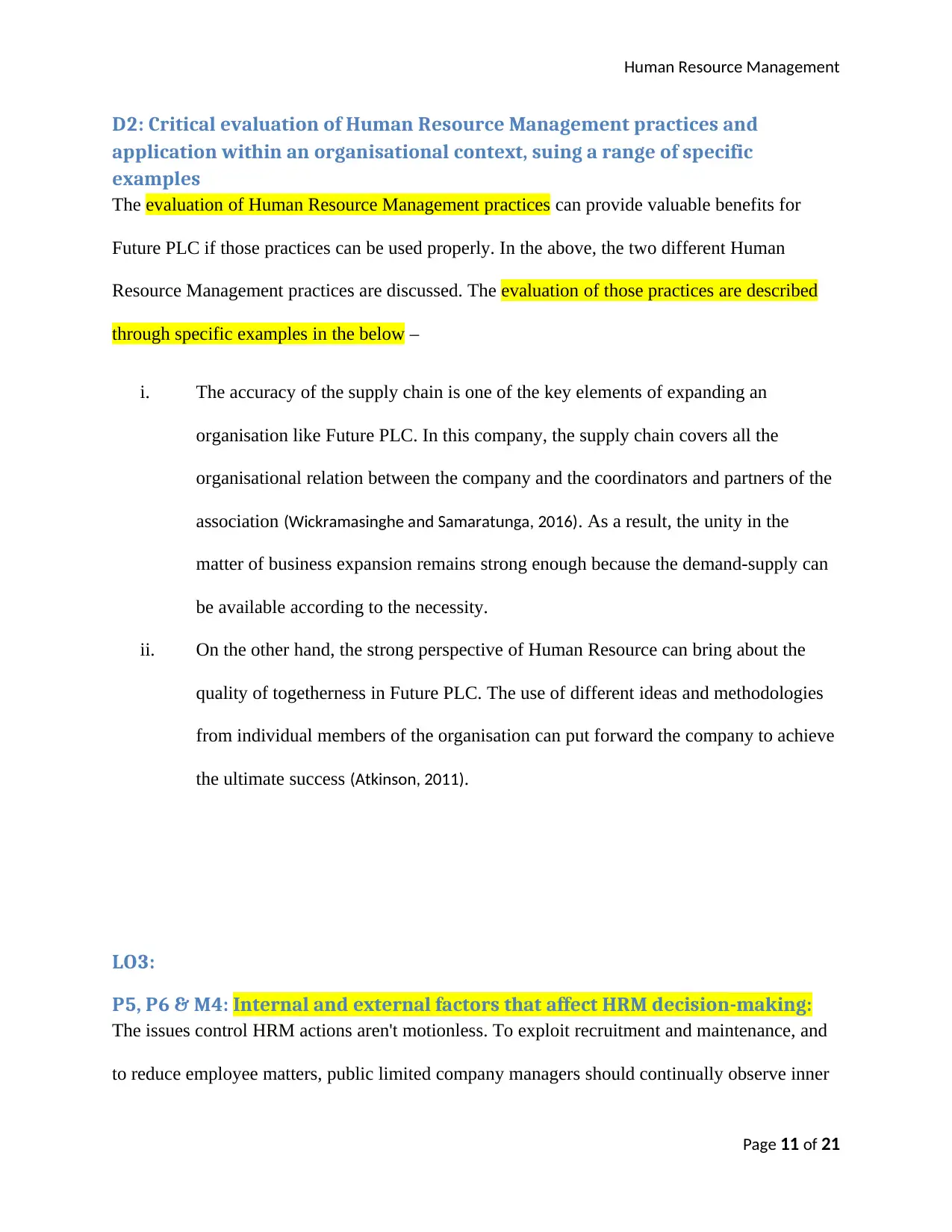
Human Resource Management
D2: Critical evaluation of Human Resource Management practices and
application within an organisational context, suing a range of specific
examples
The evaluation of Human Resource Management practices can provide valuable benefits for
Future PLC if those practices can be used properly. In the above, the two different Human
Resource Management practices are discussed. The evaluation of those practices are described
through specific examples in the below –
i. The accuracy of the supply chain is one of the key elements of expanding an
organisation like Future PLC. In this company, the supply chain covers all the
organisational relation between the company and the coordinators and partners of the
association (Wickramasinghe and Samaratunga, 2016). As a result, the unity in the
matter of business expansion remains strong enough because the demand-supply can
be available according to the necessity.
ii. On the other hand, the strong perspective of Human Resource can bring about the
quality of togetherness in Future PLC. The use of different ideas and methodologies
from individual members of the organisation can put forward the company to achieve
the ultimate success (Atkinson, 2011).
LO3:
P5, P6 & M4: Internal and external factors that affect HRM decision-making:
The issues control HRM actions aren't motionless. To exploit recruitment and maintenance, and
to reduce employee matters, public limited company managers should continually observe inner
Page 11 of 21
D2: Critical evaluation of Human Resource Management practices and
application within an organisational context, suing a range of specific
examples
The evaluation of Human Resource Management practices can provide valuable benefits for
Future PLC if those practices can be used properly. In the above, the two different Human
Resource Management practices are discussed. The evaluation of those practices are described
through specific examples in the below –
i. The accuracy of the supply chain is one of the key elements of expanding an
organisation like Future PLC. In this company, the supply chain covers all the
organisational relation between the company and the coordinators and partners of the
association (Wickramasinghe and Samaratunga, 2016). As a result, the unity in the
matter of business expansion remains strong enough because the demand-supply can
be available according to the necessity.
ii. On the other hand, the strong perspective of Human Resource can bring about the
quality of togetherness in Future PLC. The use of different ideas and methodologies
from individual members of the organisation can put forward the company to achieve
the ultimate success (Atkinson, 2011).
LO3:
P5, P6 & M4: Internal and external factors that affect HRM decision-making:
The issues control HRM actions aren't motionless. To exploit recruitment and maintenance, and
to reduce employee matters, public limited company managers should continually observe inner
Page 11 of 21
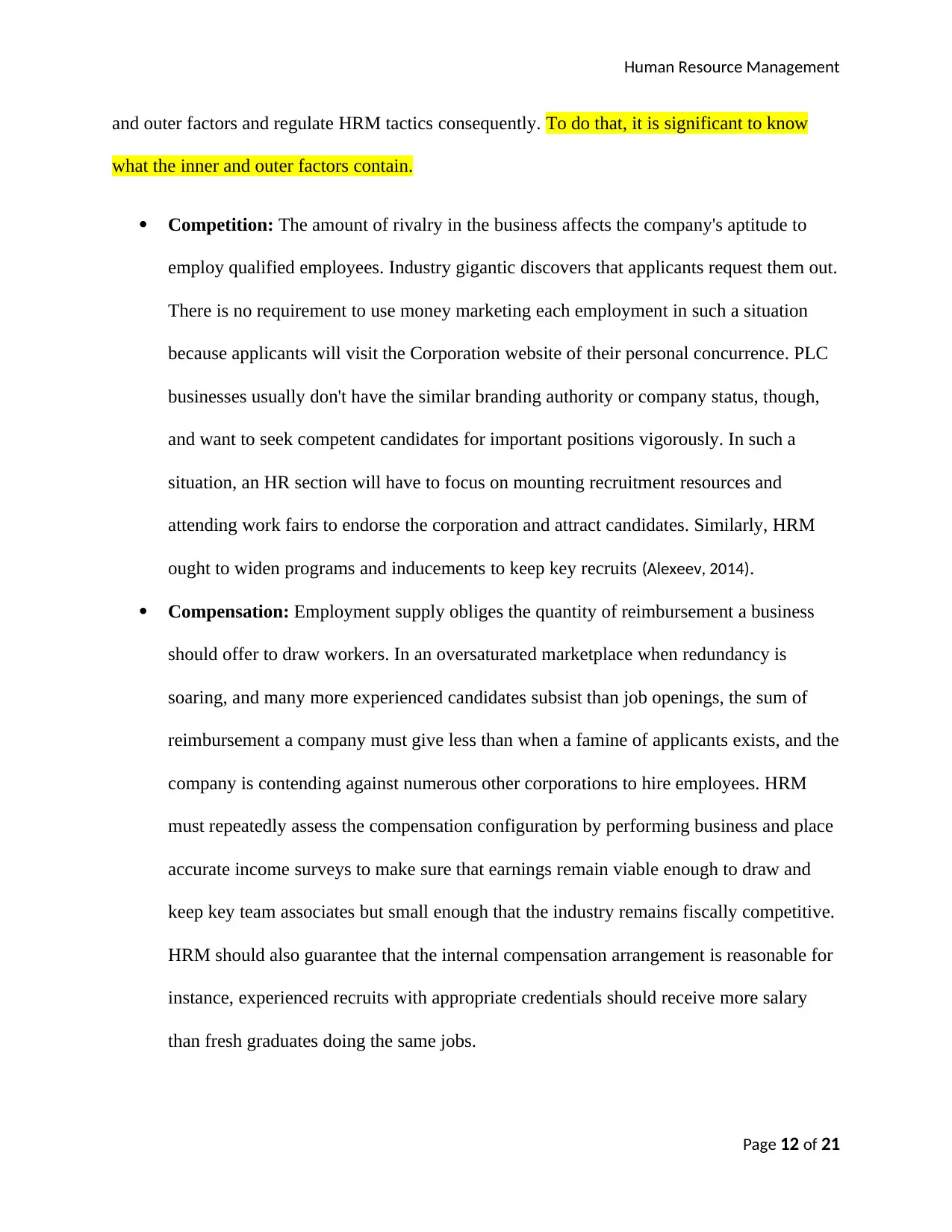
Human Resource Management
and outer factors and regulate HRM tactics consequently. To do that, it is significant to know
what the inner and outer factors contain.
Competition: The amount of rivalry in the business affects the company's aptitude to
employ qualified employees. Industry gigantic discovers that applicants request them out.
There is no requirement to use money marketing each employment in such a situation
because applicants will visit the Corporation website of their personal concurrence. PLC
businesses usually don't have the similar branding authority or company status, though,
and want to seek competent candidates for important positions vigorously. In such a
situation, an HR section will have to focus on mounting recruitment resources and
attending work fairs to endorse the corporation and attract candidates. Similarly, HRM
ought to widen programs and inducements to keep key recruits (Alexeev, 2014).
Compensation: Employment supply obliges the quantity of reimbursement a business
should offer to draw workers. In an oversaturated marketplace when redundancy is
soaring, and many more experienced candidates subsist than job openings, the sum of
reimbursement a company must give less than when a famine of applicants exists, and the
company is contending against numerous other corporations to hire employees. HRM
must repeatedly assess the compensation configuration by performing business and place
accurate income surveys to make sure that earnings remain viable enough to draw and
keep key team associates but small enough that the industry remains fiscally competitive.
HRM should also guarantee that the internal compensation arrangement is reasonable for
instance, experienced recruits with appropriate credentials should receive more salary
than fresh graduates doing the same jobs.
Page 12 of 21
and outer factors and regulate HRM tactics consequently. To do that, it is significant to know
what the inner and outer factors contain.
Competition: The amount of rivalry in the business affects the company's aptitude to
employ qualified employees. Industry gigantic discovers that applicants request them out.
There is no requirement to use money marketing each employment in such a situation
because applicants will visit the Corporation website of their personal concurrence. PLC
businesses usually don't have the similar branding authority or company status, though,
and want to seek competent candidates for important positions vigorously. In such a
situation, an HR section will have to focus on mounting recruitment resources and
attending work fairs to endorse the corporation and attract candidates. Similarly, HRM
ought to widen programs and inducements to keep key recruits (Alexeev, 2014).
Compensation: Employment supply obliges the quantity of reimbursement a business
should offer to draw workers. In an oversaturated marketplace when redundancy is
soaring, and many more experienced candidates subsist than job openings, the sum of
reimbursement a company must give less than when a famine of applicants exists, and the
company is contending against numerous other corporations to hire employees. HRM
must repeatedly assess the compensation configuration by performing business and place
accurate income surveys to make sure that earnings remain viable enough to draw and
keep key team associates but small enough that the industry remains fiscally competitive.
HRM should also guarantee that the internal compensation arrangement is reasonable for
instance, experienced recruits with appropriate credentials should receive more salary
than fresh graduates doing the same jobs.
Page 12 of 21
⊘ This is a preview!⊘
Do you want full access?
Subscribe today to unlock all pages.

Trusted by 1+ million students worldwide
1 out of 21
Related Documents
Your All-in-One AI-Powered Toolkit for Academic Success.
+13062052269
info@desklib.com
Available 24*7 on WhatsApp / Email
![[object Object]](/_next/static/media/star-bottom.7253800d.svg)
Unlock your academic potential
Copyright © 2020–2025 A2Z Services. All Rights Reserved. Developed and managed by ZUCOL.



